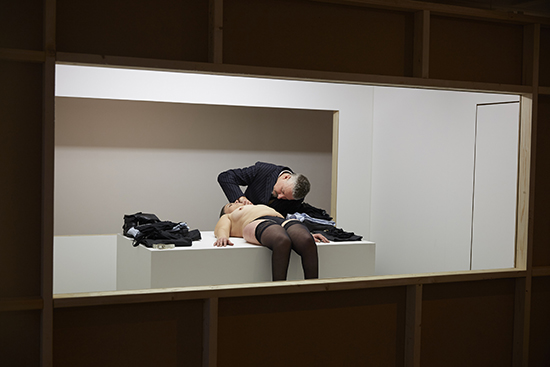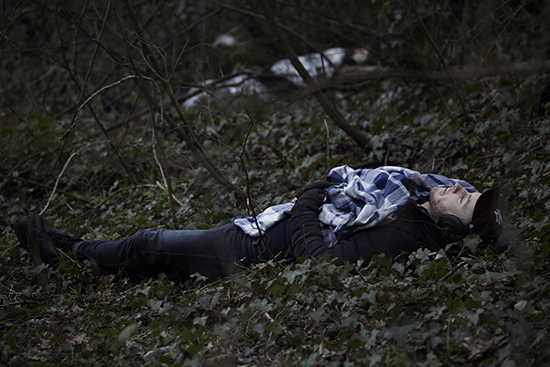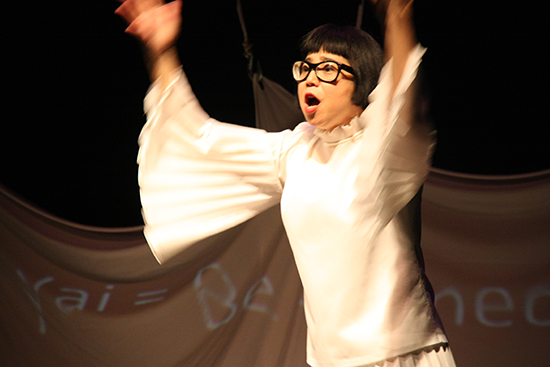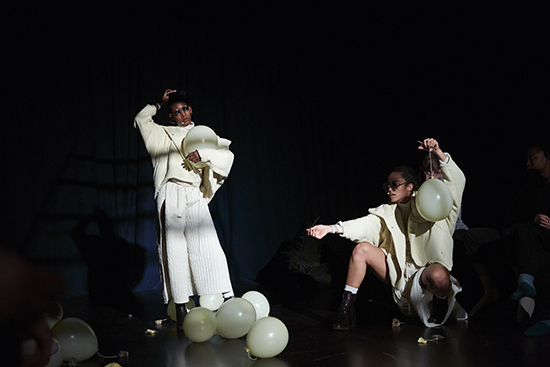Ghosts and bones and angels
Osunwunmi: In Between Time International Festival 2017

Undress/Redress, Noëmi Lakmaier, In Between Time
photo Manuel@DARC.media
Undress/Redress, Noëmi Lakmaier, In Between Time
Helen Cole, Breathe; Noëmi Lakmaier, Undress/Redress
Bristol’s IBT was more spread out this year, taking place over five days and making use of more local venues. It was quite impossible to see everything, so easier to be relaxed about what you were missing. I visit Helen Cole’s Breathe in the cellars at Colston Hall and it’s like a talisman containing the essence of the festival, as I sit on a mat of pulsing LEDs listening to invisible dancers surge and pant around me. Another time I pass a lighted cube framing a moment in which Noëmi Lakmaier, an artist with disability and inert for the duration of Undress/Redress, is methodically dressed and undressed by a strapping, fully clothed man. Apart from her eyes there is not a movement she makes of her own volition and yet the lines of power and permission could hardly be more evident.
French & Mottershead, Woodland
Thursday was bitterly cold. I took the bus to Arnos Vale, the big Victorian cemetery, but the venue was next door in the park where IBT staff were gamely shivering and rubbing their fingers in a small pavilion. You couldn’t fault their kind professionalism. I was given a smartphone, headphones, a blanket and a foil-backed camping mat. The app on the phone led me through the bare park, past the winter-bleak playgrounds; a cursor guided towards the activated circle. In Bristol the words “Arnos Vale” are so evocative of peace and memory, the aura of the cemetery still whispered around me. I struggled with my bundles along the path into a sparse patch of woodland. Now I was in the significant circle.
Leaves messed up the muddy ground between trees. I skirted mud, leaves and thorny whippy shoots to find my own little leafy nestling spot. Lying down, I began to listen.

Woodland, French & Mottershead, In Between Time
A mature female voice started to tell me, now that I had died, how I was beginning to decay. Blood pooling, temperature dropping: each little step described thoroughly, serenely. I looked up through branches into grey sky and was immersed in this tale of gradual putrefaction. The details were precise, pinned to me with pronouns and possessives: bot flies land and swarm (on me.) Flesh melts, skin blackens, organs ferment (all mine.) I observed, dispassionate.
The voice was self-consciously as soothing as possible. But as I listened, it proved too quiet for this semi-urban location. I heard traffic, lawnmowers, people being loud on their phones, and I lost the words being spoken into my ear. Worse, I began to hear one or two value words, something was named “toxic,” something else was “foul” in some way: it jarred me out of the meditation. I wanted more specificity, and more objectivity, and less direction as to my feelings: ‘How toxic?’ I wanted to ask, ‘To what?’ ‘Why are your badgers more sympathetic than your maggots?’
Time was variable in this account, a minute represented hours, days or years. The seasons turned as the body disintegrated. By the time summer came with a heap of fragile bones, I had slipped more into sympathy with the lesson, which clearly depends on the disposition of the listener to be effective.

Stacy Makishi, Vesper Time, In Between Time
photo Tamsin Drury
Stacy Makishi, Vesper Time, In Between Time
Stacy Makishi, Vesper Time
London-based Stacy Makishi is from Hawaii. A small woman, she is waiting for us as we filter into the auditorium. She has a patter going, an ease with the overtures of friendliness, of introductions and making people comfortable. And she has the air of a veteran performer, versed in the vagaries of stand-up, long in the lists of cabaret. Explaining the word ‘vespers’ she promises us something between a memoir and a sermon.
We are an open and generous audience, but surely we expect disruption and deconstruction, not faith and confessional? Still, her persona is charming and chirpy, maybe she can carry us along.
I love her clothes. In her 50s, she is both chic and cute. She has on a white filmy pleated trouser suit with bell sleeves, on her feet scarlet vinyl mules. Her black hair is in a bob and she wears the serious heavy-framed glasses of a young mod. On each side of the stage is a plain black wooden stool. One has on it a white American mailbox with a little red flag. On the floor beside the other is a magnificent pair of iridescent-white plastic high-heeled clogs, sitting there like a promise. At the back of the stage hang white sheets, a curtain of ropes, hooks and sails.
Now Vesper Time begins. We are charmed, teased, coaxed, we do a little audience participation; a promise is made to us, dependent on whether we can join in wholeheartedly. She references family, religion, loss, love and courage, Patrick Swayze and Moby Dick. Makishi uses kitsch tricks, shamelessly invokes the spirit of popular music and cheesy cinema with clips projected onto the white curtain. Our participation is gauged shrewdly, managed expertly, manipulated like a boss. But it is a fair exchange: she has already revealed herself and the ways in which she is vulnerable to us, hardened live art appreciators.
As her reminiscing continues, the ground it covers becomes more difficult and painful. Yet the more vulnerable she is (and she is always funny), the more artifice and skill kick in. The props are versatile; the white curtain, activated, becomes many things. Suddenly on this sparse stage, with masterful puppetry, there is the white whale, there is agony, there is power, there is spirit. The threads of her eloquence, presence and stagecraft have been woven into a shocking, diaphanous apparition—and then, we come back to earth. This time, loving the cheese of it, we can join in with her and Tracy Chapman and sail over that bridge.
Stacy Makishi was transcendent, meticulous, earthy, delicate, cheesy and sophisticated, and she attained the wearing of the most kitschy, the most fabulous shoes.
Voodoo, Project O, In Between Time
photo Manuel@DARC.media
Voodoo, Project O, In Between Time
Project O, Voodoo
Notes are projected in the dark. As I read, I feel familiar. I know this territory, I can recognise these moments and these conversations. It’s a collection of evidence with an inclination towards black consciousness: personal moments, pop culture, landmark events, shocking things, fun things, trivial things. This is the prologue to the piece. Depending on how I relate to this I will be at home with the work or be challenged by it.
We’ve been ushered in by attendants draped in black, we shuffle about to find a seat, sit down and read the slides or whisper to friends.
The two dancers make their way to us in a constrained and systematic series of gestures. They wear white quilted, pleated garments and blocky black high-heeled shoes. They demonstrate a confinement, an entanglement and then a birth. Each emerges with a long steel pin in her hair. White balloons are burst and bones are flung on the floor. They play us, singing, touching, chanting at us.
We are exhorted to retreat to the sides of the room and remove our shoes. The music is insistent, the sound escalating. The dancers themselves are shrieking, whistling, talking and signifying. All instructions have to be repeated till we get it. We are a little slow and it is not at first clear what is noise, what is atmosphere and what is direct instruction. We are urged to our feet, told to claim our space. We are to surrender to the music. We must move and then we must dance. The build-up and instruction are repeated, steps up a hill.
There was darkness, there was pulsing music. I looked up and saw bones suspended on a net above us. It was like being in the bowels of a ship (‘What ship?’ Ask yourselves.) Forced into history, it was we who were the ghosts.
The loud voice said at last, exasperated, “You’re all going to die! So dance!” And since this is true, I perked right up and got into it. Not everybody could, or liked it: about a quarter of us sat this out. But I felt I was somewhere I understood deeply, and I’d not been out dancing for more than a year. So for me, it was a wonderful breakthrough, and I was grateful. Dance like the Devil, for tomorrow you die.
Then there was closure, the lights came up and the music changed, and the two priestesses of this movement danced themselves with some frenzy down the aisle between us till they reached the far wall and sat, still and in darkness, inscrutable, gazing at us as we left. They would work this ritual, two hours twice a day for two days of the festival. They had done an impossible thing, and endured.
……………………
Read more about Noëmi Lakmaier’s Undress/Redress as well as another of her works, Cherophobia, in which her immobilised body is lifted by 20,000 helium-filled balloons, and watch a video interview. Stacy Makishi’s body of work is also worth exploring.
–
In Between Time, IBT17 Bristol International Festival, Artistic Director Helen Cole, Bristol, UK, 8-12 Feb
RealTime issue #137 Feb-March 2017







